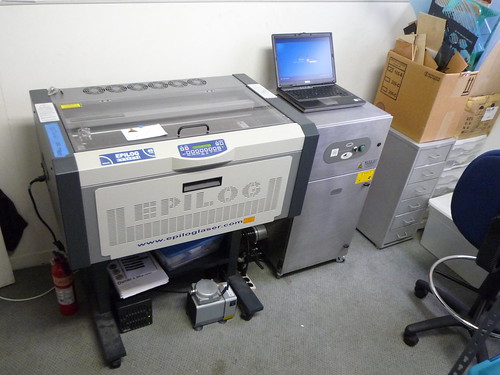Crash Space has a laser cutter!
(more exactly, it's Tod's personal laser cutter on loan for a while.
Please treat it with care. And please, DO NOT USE IT WITHOUT TRAINING)
learn a lot about laser cutters: http://www.idacontrol.com/articles.php?nid=10
For details on pricing, reservations, etc. see Laser Cutter Rules.
For the procedure on how to operate the laser, see Laser Cutter Checklist.
Note that even with the Checklist, you still need to be a checked-out operator to run the laser.
What We Will Do With It
Primarily we want to make money for the space with it.
- Have classes on how to use it for the public
- Charge per-minute to members for use
- Maybe some contract jobs
NYC Resistor has a lot of experience using their laser cutter to benefit their space, we should look at their results.
What It Can Do
The laser cutter can either cut or engrave many different kinds of flat material.
Materials it can cut or etch:
- Acrylic (aka Lucite, plexiglass)
- ABS plastic (usually, depends on formulation)
- Wood (not pressure treated, plywood okay usually)
- Paper/Cardboard
Materials it cannot cut:
- Anything containing chlorine. This includes vinyl and many plastics, as well as Moleskine notebooks. If you’re not sure whether what you’ve got contains chlorine, you can do a burn test to check.
- Metal of any kind. unless you use laser cermark. a ceramic marking compound
- Glass cutting. It etches OK, but we can’t cut it.
- there are some even some laserable fabrics
If you are unsure about your material, don't stick it in the laser. Find the MSDS sheet if you can, or ask Tod his opinion.
How To Use It
The laser appears as a printer to Windows. So "just print to it", sorta.
- Vector art with "hairline" width (<0.001") will be cut, anything else will be rasterized and engraved
- There is a special print driver dialog used to configure laser settings like power/speed/etc.
- "Print" your file via a vector art drawing program (normally CorelDraw see below)
- That sends the job to the laser, you must then trigger the laser by hand
- Don't do any of this without training, though. We'll have regular workshops to get qualified on it.
File Formats
The "driver" for the laser cutter is a laptop with CorelDraw. CorelDraw is a vector drawing program similar to Illustrator. It can handle most file formats like:
- Illustrator v10 - vector + bitmap, keeps layers intact
- EPS - vector format for cutting
- PDF - vector format for cutting
- PNG - bitmap format for engraving
- GIF - bitmap format for engraving
- JPG - bitmap format for engraving
- DXF - Autocad format
- and most others
Unless you have an Illustrator v10 file, usually you'll open up your artwork in a new CorelDraw document, then position it, make sure all vector cut lines are set to "Hairline" and then "print" to the laser cutter from CorelDraw.
Some Useful Links
- http://www.epiloglaser.com/downloads/pdf/mini_helix_dec_2009.pdf -- Manual for this laser
- http://www.thingiverse.com/tool:33 -- Things you can make with a laser cutter
-
http://epiloglaser.com/sample_club.htm -- Ideas from the maker of the cutter
-
http://www.ladyada.net/library/laser/ -- Ladyada's notes
- http://www.sawmillcreek.org/forumdisplay.php?f=8 -- Sawmill Creek Engraver forum, good discussions
- http://www.nycresistor.com/laser/ -- NYC Resistor's laser page
- http://wiki.metrixcreatespace.com/laser-cutter -- metrix create:space laser guide and pricing
- http://metrixcreatespace.com/post/1607467830/changes-to-laser-prices -- addition rules and resources for plastics and revived pricing
- http://www.nycresistor.com/2008/08/28/how-to-identify-polymers-with-burnination/ -- flame test your plastics
- How to identify plastics :plasticsidentification.pdf
The Laser Cutter
The laser cutter setup consists of the parts:
- Epilog Mini 24 45 Watt laser cutter (24x17in cutting surface)
- Purex Laserex filtration system
- Air compressor
- Tripp lite line conditioner for laser cutter power smoothing
- Dell laptop driving laser cutter through Ethernet crossover cable
- Fire extinguisher for when things go horribly wrong
(click image for notes on what parts are what)
To Import files in to Corel Draw
Draw a reference square, it a 1 inch square before exporting. This way you can check the size of the reference square in Coral and resize accordingly.
When experimenting with a new tool chain for the first time it is always a good idea to double check that layers didn't sneak into your piece. layers can be a bit difficult often they'll be exported as multiple lines exactly atop one another. Even if you don't use layers on the original these will show up and cause the laser to go over each feature two and sometimes 3 times. This is not only wasteful but time consuming. the easiest thing is to save your work then start clicking and dragging each feature around to ensure there are not duplicates under them.
PDFs on Inkscape on Linux. Lines at 0.050 mm imported reliably as hairline. My settings were: PDF 1.4, convert text to paths (on), PDF+latex (on), rasterize filter effects (on), resolution for rasterization (600), export area is drawing (on), export area is page (on), limit export to the object with id (blank).
DXF files that work well on the laser. Use the "Desktop Cutting Plotter (R13)" output with the default settings: - use ROBO-Master type of spline output: [ ] (off) - use LWPOLYLINE type of line output [x] (on)
EPS from Inkscape with the default settings works as well.
Local sources for materials
In south bay: Superior Plastic 2124 W. Rosecrans Ave Gardena, CA 90249 310.515.5111 (Plexi, ABS. Others: Styrene, HDPE, PC)
Up the street from Crashspace:
I Love Lucite - Craig has a large supply of acrylics to choose from.
3300 Motor Ave
Los Angeles, CA 90034
